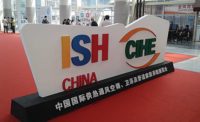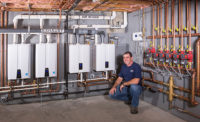Products at ISH 2015 address energy efficiency
The 2015 ISH trade show was held March 10-14 in Frankfurt, Germany.

ISH attendees pack the exhibition hall that displays energy-efficient heating equipment. Photo courtesy of Messe Frankfurt Exhibition GmbH/Jens Liebchen

Viessmann displays hybrid heating equipment that uses oil or gas plus a renewable energy source. Photo by Bob Miodonski/Supply House Times

Viessmann displays hybrid heating equipment that uses oil or gas plus a renewable energy source. Photo by Bob Miodonski/Supply House Times

Young German plumbers view a plastic pipe-cutting demonstration during ISH in the Milwaukee Tool booth. Photo by Bob Miodonski/Supply House Times




Many of the plumbing and heating products on display at the ISH trade show March 10-14 in Frankfurt, Germany, will never make it to the U.S. market. Their technologies, however, address major industry issues on both sides of the Atlantic: energy efficiency, water quality and water consumption.
Produced every two years, ISH Frankfurt traditionally has featured stylish European design in its plumbing exhibition halls and ever-increasing energy efficiency in its heating equipment halls. In 2015, those lines started to blur with greater emphasis on water-efficient plumbing products and better-looking heating appliances.
“Sanitary equipment always was design-oriented and heating was all about efficiency. Now it’s a combination,” says Wolfgang Marzin, president and CEO of Messe Frankfurt GmbH, the company that produces ISH. “The heating equipment always used to be in the basement or behind the wall. Now you can put your heating equipment next to your TV.”
Nearly 200,000 attendees viewed the products of nearly 2,500 manufacturers with booths at ISH. The estimated 198,000 visitors and 2,465 exhibitors both represent record highs for the show.
ISH continues to be an international affair with 61% of exhibitors and 37% of visitors coming from countries outside Germany. Nations with the largest contingents are Italy, France, the Netherlands, Switzerland and China with significant growth in the number of U.S., British and Irish visitors.
“The German market alone would not be sufficient to host a show of this kind,” Marzin says. “From the beginning, all the leading shows in Germany needed to think internationally.
“ISH combines the big issues of the world. Energy efficiency, water quality and water consumption are among the big topics in the world today.”
Energy efficiency
Heating equipment that utilizes renewable energy sources such as solar power and wood pellets has been displayed at ISH since at least the mid-1990s. That’s still the case in 2015, with products that shift the fuel source away from fossil fuels and, in Europe, from nuclear power.
Some manufacturers exhibited systems that use traditional fuel sources more efficiently. Aquatherm, for example, showed its black pipe system for radiant heating and cooling ceilings and walls as well as floors. Bosch displayed advanced condensing – and good-looking – wall-hung boilers under a number of its brands such as Bosch, Buderus and Junkers. In its booth, Viessmann combined the best of both worlds with hybrid systems that use oil or gas plus a renewable energy source.
During a press conference March 12, company owner Dr. Martin Viessmann said the success of the renewable energy era rests on the shoulders of heating industry professionals. The heating market accounts for 40% of energy consumption, making it the largest primary energy consumer.
“The sustainable energy era can only succeed if energy efficiency is significantly increased,” he said. “We need to increase energy efficiency and the heating industry is the key to doing this. Many obsolete heating systems need additional subsidies for modernization of heating systems that are reliable.”
The heating industry can offer solutions to the volatility that comes from generating electricity through renewable energy sources such as solar and wind power, he said. This can be accomplished by developing storage for excess energy. He labeled two ways to do this as “power to gas” and “power to heat.”
The first concept involves power from renewable energy being converted into hydrogen using electrolysis. Adding carbon dioxide to it results in synthetic methane, which then can be stored, transported via a nationwide gas network and used as energy.
Putting its money where its mouth is, Viessmann last year installed the world’s first industrial-scale power-to-gas facility at its headquarters in Allendorf, Germany.
The power-to-heat concept involves decentralized, short-term energy storage in buildings with heat pumps, which can be turned on when power is less expensive and energy demand is lower. The power can be transformed into heat very efficiently, stored in a buffer cylinder and later used to heat the building.
“New concepts in self-generating power and its utilization, as well as decentralized energy storage, provide an enormously promising opportunity to ensure the sustainable energy era’s success,” Viessmann said.
Water quality, consumption
Much as is the case with energy efficiency breakthroughs from heating equipment manufacturers, German regulations are driving innovations on water quality through strict standards on drinking water. Among manufacturers exhibiting drinking water-hygiene systems at ISH were German companies Kemper and Viega.
“Drinking out of the tap in Germany is quite common because the water quality is very high,” says Stefan Schulte, a Viega product manager. “Impeccable drinking water is a requirement to our health.”
In the U.S. market, the focus on healthy drinking water includes minimizing the risk of legionella bacteria and other waterborne diseases, says Derek Bower, P.E., Viega’s U.S. director of product management for metals. Systems developed for the U.S. market need to address issues such as stagnation of water in plumbing pipes and water temperature.
Viega plans to adapt its water quality technology to the U.S. market as it continues to educate the U.S. plumbing industry on water quality issues, Marketing Manager Tim Allbritten says. The company has scheduled a water quality workshop July 21 in Chicago.
Along with displaying contemporary designs, plumbing manufacturers from Europe, North America and Asia displayed products that offer sustainable sanitation and water management solutions. Plumbing brands known to U.S. visitors include Kohler Co., Vitra, Dornbracht, Duravit, Franke, Grohe, Hansgrohe, Ideal Standard, KWC, Villeroy & Boch and TOTO.
Falcon Waterfree Technologies displayed its water-saving hybrid urinal configured for both the U.S. and European markets. The European version features a mechanical valve while the U.S. product is equipped with a velocity cartridge.
Grohe and Hansgrohe designated areas at ISH for plumber training. The Grohe Professional mobile education center, which is housed in a two-level semitrailer truck, was parked outside an exhibit hall. The first level features product displays, and upstairs is a classroom. Hansgrohe reserved a section of its exhibition space for members of its Technical Service Center to explain to tradespeople how their products function.
The next ISH Frankfurt will take place March 14-18, 2017.
“We can have a trade show with such a big investment only every other year. It would be too big to do every year,” Marzin says. “Also, the innovation cycle in sanitary, heating and HVAC is more of a two-year cycle. Since companies look forward to launching their products at the world’s leading show, which is ISH, it just has to be every other year.”
This article was originally titled “ISH takes on issues” in the July 2015 print edition of Supply House Times.
Looking for a reprint of this article?
From high-res PDFs to custom plaques, order your copy today!










